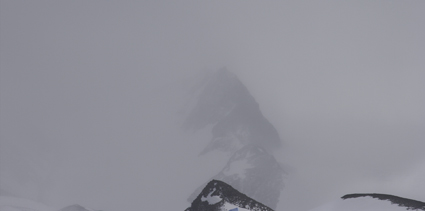Take A Break
In 2005 I made the voyage from Ushuaia Argentina to the Antarctic Peninsula to colead a photography workshop with five other instructors – Michael Reichmann, Stephen Johnson, Jeff Schewe, and Seth Resnick, along with 45 participants. It was tremendously stimulating to be in the company of such diversity and observe our varied creative processes. The journey was the fulfillment of a long standing wish to visit Antarctica, made as a young man while watching my mother shepherd the production of photographer Eliot Porter’s book on the region. With so many influences, I knew the key to personal success lay in finding my own voice amid so many.
Antarctica is so exotic it seduces you instantly. Because everything was interesting and different to us, many participants joked that, “You couldn’t make a bad picture.” But I knew a key question that success hinged upon answering was, “How different were our pictures from one another’s and from those that had been made before ours?”
It was natural that we wanted to maximize our time shooting with only seven days on the peninsula, three were lost in transit during our crossing of the Drake Passage, the roughest seas in the world, and our first trip could be our last, as it was a rare opportunity. When we weren’t sleeping, we were always on the lookout for more photographs. And we slept only a little, because the days were long, as the nights were little more than a period of twilight after an hours long sunset and before an hours long sunrise.
At one point in my journey, I realized I had reached a saturation point and needed to look inward to process the overwhelming stimulus, reorient, and reconnect. It wasn’t rest I needed most. It was reflection. During one of only fourteen opportunities, instead of going to shore to photograph, I made a few exposures from the ship decks – one of which worked (this one) – and I went down below and wrote in peace and quiet.
You can read what I wrote here.
It was time well spent. During that time I was able to ask the important questions, connect the many new pieces I had found to this puzzle, clarify my understanding, returning with renewed energy and purpose. Later, when my friend Seth Resnick looked at my finished images he said two things that were music to my ears. First he said, “Where did you find that one?” He had been standing next to me when I made the exposure; we had seen entirely different things – and that is the way it should be. Then second he said, “Your images are so you!” That was my goal. I wouldn’t have reached it without a lot of passionate, smart, hard work and more than a little reflection. And for both, I needed to take a break.
Taking a break isn’t easy in an era and culture that prizes productivity so highly. But there are times when you need to take a break. But … Why? When? How often? And, what do you do on a break? While there’s no one answer for every individual and situation, you’ll find lots of advice on the subject, some good and some bad. Take the good, leave the bad.
Do be mindful. There’s more than one kind of break to take. We need to take breaks to recharge our batteries; to energize we need rest, relaxation, and entertainment; these are usually but not exclusively longer breaks that don’t involve productivity in another area; the goal is renewed energy. We need to take breaks to find a fresh perspective; walk away from the problem or sleep on it; these are usually shorter breaks that often involve productivity in another area or switching gears sometimes making unexpected connections; the goal is insight. There are many other reasons and ways to take breaks.
The time to take a break is after you’ve thoroughly researched a challenge and put your understanding through systematic tests to confirm it and clearly identify the most promising avenues for further inquiry. Then, you need to walk away from the problem, clearing your mind entirely of it, so you can return to it with a fresh perspective. Generally, in the time in between, your subconscious has put the pieces … it may even find that ever elusive missing piece.
Curiously, many great breakthroughs in history have come when people sleep on it. Valuable insights have been found during sleep for individuals as diverse as Alexander Graham Bell, C J Jung, Mary Shelley, and Jack Nicklaus leading to discoveries such as James Watson’s uncovering of the double helix structure of DNA; Friedrich Kekule’s visions of the structures of the carbon atom and benzene molecule; Dimitry Mendeleyev’s creation of chemistry’s Periodic Table; Elias Howe’s invention of the sewing machine needle; and many others.
Questions
What are the benefits of taking breaks personally?
What are the benefits of taking breaks professionally?
What break frequency is optimal for you?
What break duration is optimal for you?
What activities during breaks are most regenerating for you?
What activities during breaks are most stimulating for you?
What activities during breaks are most enjoyable for you?
Are you good at distinguishing between taking a break and switching activities?
What do you need to do to really take a break?
What can you do to clarify your goals for your break?
Find out more about this image here.
View more related images here.
Read more The Stories Behind The Images here.



